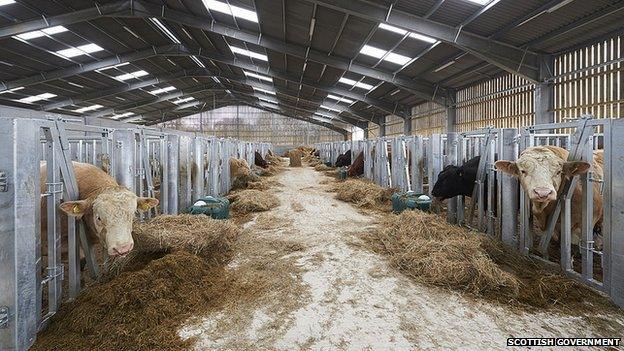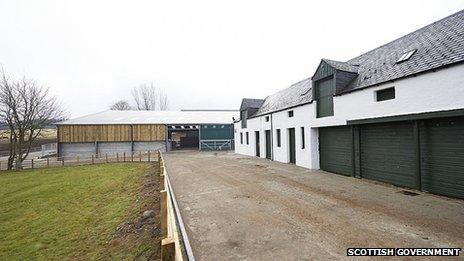Rent-a-stud: Government bulls-for-hire scheme
- Published

The Scottish government's bull stud continues a scheme that was started in the 1800s
Environment Minister Paul Wheelhouse has being given a tour of a government-owned bull stud farm following a £3m revamp. But why does the Scottish government offer bulls for hire?
On the southern outskirts of Inverness lie the farms of Knocknagael and Balrobert.
Nearby are the city suburbs of Culduthel and Holm Dell with family homes and flats constructed during the 1990s and 2000s.
In some ways the green fields of the farms are remarkable in that they are still wide open park land in an area where new housing is still being built.
Knocknagael and adjoining Balrobert form the Scottish government's bull stud.
The scheme has its roots in the Victorian age and a period of farming improvements.

Hereford bulls were popular in the 1980s
Following the passing of the 1897 Congested (Scotland) Districts Act, the Department of Agriculture offered crofters bulls and rams free of charge to help improve the quality of calves and lambs.
Aberdeen Angus was the first breed to have been used for bulls and they bred with the crofters' Highland and Shorthorn cross bred cows. An average of 290 bulls-a-year were used between 1929-38, 256 from 1939-44 and 270 between 1944-49, according to official figures.
After World War II, bulls were still offered free of charge but crofters had to contribute to the cost of over-wintering the animals at Inverness.
Between the 1960s and the 1990s there were several key changes to the scheme.
In 1961, crofters on the islands of Lewis and Harris switched to a paid-for, department-run artificial insemination scheme. Even after that move, 70% of cows on crofting townships were still being serviced by a bull according to official figures published in 1975.
Rising costs
For those still using the free bull service, the breed of animal changed. Aberdeen Angus fell out of favour and Herefords and Simmentals became popular in the 1980s and then Limousins in the 1990s.
In 1992, following a review, the department ended the free element of the scheme and started charging for the hire of bulls. In 1996 the scheme was handed over to the Crofters Commission.
More recent times have seen a move to wind up the scheme altogether because of declining use of the bulls and rising costs of keeping them.
Between 2006 and 2008, an average of 120 bulls were hired to about 450 participants in 106 crofting townships, according to Scottish government figures.
These bulls were servicing 4,083 cows in 2008 out of a total of 28,315 cows held on crofts.
Also by 2008, it was costing crofters £1,250 to hire an animal. The government said without the subsidy it would have cost crofters £3,400.
However, following protests from some crofting communities, the government decided to continue running the scheme but at a reduced level.
It was also agreed to revamp the stud farm, something that had been needed for sometime at the site which is now managed by the Scottish government's Rural Payments and Inspections Division.
Outdated buildings have been demolished and new ones built.
Wildlife surveys were carried out ahead of the new construction and the results have led to the creation of a bat roost, erection of bird boxes and hedge planting.

The stud at Inverness has undergone a £3m revamp
Last year, 102 bulls were hired out to 88 crofting groups involving about 400 individuals. This season, 97 bulls will be hired out to 84 groups, again involving about 400 crofters.
Environment Minister Paul Wheelhouse said the stud was important to Scotland's agricultural industry.
He said: "The Crofting Cattle Improvement Scheme is vital for our crofters giving them access to high quality, healthy bulls which ensures they can provide quality calves to improve the productivity of crofts and boost the supply of premium product for the Scottish beef industry.
"The modernised stud provides quality modern accommodation for the bulls which is more fit for purpose with an increased emphasis on health and safety and we have optimised the bulls' welfare needs."
Crofting Commission convener Susan Walker added: "Crofters throughout the crofting counties will feel encouraged that Scottish government listened to the calls for the bull scheme to be retained.
"The investment in this new facility demonstrates the government's increasing commitment to crofting and a recognition of the contribution crofting can continue to make by producing high quality animals for Scotland's food industry."
But fresh controversy may not be far away for the government stud.
To recoup some of the £3m cost of the improvements, it has been proposed selling three fields deemed surplus to requirements.
Planning permission has been sought from Highland Council for up to 190 homes and new woodland.
Opponents to the proposal want the land to remain available to farming.
A new battle is looming over the future of the stud's green fields.
- Published14 March 2013
- Published12 September 2011